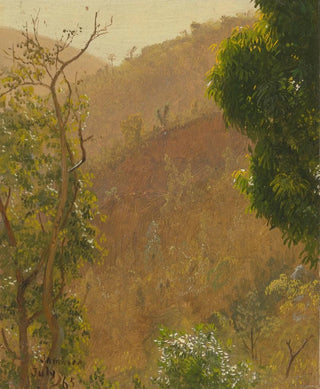Art print | Landscape IV - Frederic Edwin Church


View from behind

Frame (optional)
In the fascinating universe of art, some works manage to transcend their era to become symbols of beauty and contemplation. "Paysage IV" by Frederic Edwin Church fits perfectly into this tradition. This painting, which evokes grand landscapes and majestic skies, invites the viewer to a complete immersion in nature. Light, movement, and color combine to create a lively tableau, where every detail seems to breathe harmony. The artist, a prominent member of the Hudson River School, offers us a romantic and idealized vision of the natural world, a true call to escape.
Style and uniqueness of the artwork
Frederic Edwin Church's style is distinguished by his ability to capture the magnificence of nature with almost photographic precision. In "Paysage IV," the artist uses a rich and vibrant palette, where shades of green, blue, and gold blend to give life to a landscape that is both realistic and dreamlike. The skies, often adorned with dramatic clouds, create an atmosphere of wonder and serenity. Church manages to establish an emotional connection with the viewer, inviting them to feel the grandeur and beauty of the natural world. His painting technique, marked by delicate brushstrokes and meticulous details, demonstrates a deep respect for his subject, transforming each canvas into an ode to nature.
The artist and his influence
Frederic Edwin Church, born in 1826, is one of the emblematic figures of the American Romantic movement. As a disciple of Thomas Cole, he developed a personal style that combines realism and idealism. Church was not just a painter; he was also a passionate explorer, traveling through landscapes of South America, from the Andes mountains to Icelandic volcanoes. These experiences enrich his work, allowing him to translate the splendor of the landscapes he discovered. His influence extends beyond his time, inspiring many artists to explore themes of nature and the sublime. By incorporating elements of light and atmosphere, Church paved the way for generations of artists seeking

Matte finish

View from behind

Frame (optional)
In the fascinating universe of art, some works manage to transcend their era to become symbols of beauty and contemplation. "Paysage IV" by Frederic Edwin Church fits perfectly into this tradition. This painting, which evokes grand landscapes and majestic skies, invites the viewer to a complete immersion in nature. Light, movement, and color combine to create a lively tableau, where every detail seems to breathe harmony. The artist, a prominent member of the Hudson River School, offers us a romantic and idealized vision of the natural world, a true call to escape.
Style and uniqueness of the artwork
Frederic Edwin Church's style is distinguished by his ability to capture the magnificence of nature with almost photographic precision. In "Paysage IV," the artist uses a rich and vibrant palette, where shades of green, blue, and gold blend to give life to a landscape that is both realistic and dreamlike. The skies, often adorned with dramatic clouds, create an atmosphere of wonder and serenity. Church manages to establish an emotional connection with the viewer, inviting them to feel the grandeur and beauty of the natural world. His painting technique, marked by delicate brushstrokes and meticulous details, demonstrates a deep respect for his subject, transforming each canvas into an ode to nature.
The artist and his influence
Frederic Edwin Church, born in 1826, is one of the emblematic figures of the American Romantic movement. As a disciple of Thomas Cole, he developed a personal style that combines realism and idealism. Church was not just a painter; he was also a passionate explorer, traveling through landscapes of South America, from the Andes mountains to Icelandic volcanoes. These experiences enrich his work, allowing him to translate the splendor of the landscapes he discovered. His influence extends beyond his time, inspiring many artists to explore themes of nature and the sublime. By incorporating elements of light and atmosphere, Church paved the way for generations of artists seeking






